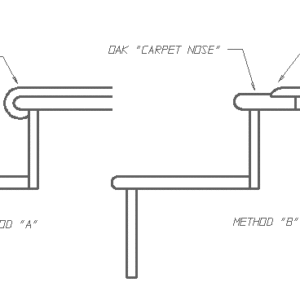Staircase up from main to second. Finish is painted risers, clearcoat hardwood treads. Treads all 1″ thick. Second floor finish is carpet, so we transition at or near top tread. Take a look at the attached sketch, and tell me which you prefer to do.
Method “A” has a 1″ “rough” tread, and the carpet is wrapped around the nose, finishing up under the nosing.
Method “B” has a 1-1/4″ hardwood nosing matching species and finish of stair treads, and a few inches of top surface, then is rebated down 1/4″ where the carpet is brought to a finished edge.



















Replies
FWIW..I like door # 1 Monty..less chance of a trip, I think.
I like the full wrap as in Method #1.
It looks finished to me.
The method number 2 is more like whoops, forgot somthing!
So, I am all set to do this per method "A", replace the temporary top tread with the 5/4 bullnosed edge pine for the full carpet wrap, and my finish carpenter, who is doing treads and risers on the wood staircase, pipes up and suggests "A" is bad, and describes "B"
He says, 1.) it looks more finished, and 2.) the carpet will take heavy wear on the top tread point if wrapped as in "A", whereas the more durable hardwood tread of "B" will look better after usage.
BTW, the stair carriages were built with "A" in mind, and the staircase rise is 7-5/16 throughout, carrying through at the top, presuming a 3/4" carpeting thickness. Doing a "B" scheme has the top rise 1/2" shorter, at 6-13/16", measured wood-to-wood. The rise matches the one below when measuring back at the point where the carpet comes into play.
Okay, now i have a question..........
Isn't the top tread, the second floor, itself?
Is there a tread sticking out from the floor?View Image
Yeah, the second floor level is where the top tread is. The "tread" is an extension of the subfloor where it joins the top of the staircase.
I build a lot of stairs, and while I don't personally care for the look "A" the wrapped landing tread, it works and takes care of the transition safely.
I've never seen your "B" method. What's to keep the carpet in the rabbet?
The landing tread I work with has a nose that's the same thickness as the treads ( a fat inch), and most has a groove in the back to fit a flooring tongue. I like to modify that with a sloped rabbet that the carpet tucks under.
A good carpet installer can butt right to the landing tread, too. EliphIno!
That was a little too big, sorry 'bout dat. Never have figured out how to delete funked up pics<G> EliphIno!
I agree with Billy--the top tread/nosing is rabbeted on the bottom so that the carpet can finish flush with it, not slightly up as shown in your detail B. This of course changes your riser height slightly at the top and therefore may funk up your overall elevation plan if you've already cut the stringers. You want to avoid presenting a rolled carpet edge for wear, in my opinion.
I personally think "A" looks more finished, and I just don't see how you would do "B" without there being at least some chance for a trip hazard no matter how you do it.